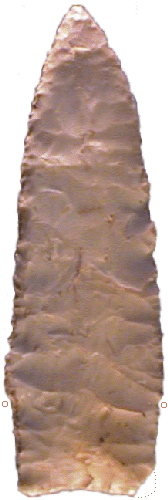

Point Type: HOLLAND
Also See: Colbert-Dalton, Dalton, Dalton-Greenbrier, Dalton-Hemphill, Golondrina, Hardin, Plainview, Scottsbluff , Sloan-Dalton
Location: Midwestern United States
Associated Dates:
9,500 - 8,500 B.P. - Transitional Paleo - Early Archaic
Morphology: Lanceolate
General Description: The Holland is a large, thin, stemmed, lanceolate point with slight shoulders which are one to two mm wider that the stems. The flaking pattern may be collateral to random and shallow with flakes removed being broad and flat. The large initial finishing flakes removed were generally struck so that they produced a slight cupped edge, curving upward towards the center of the blade which is similar to the common technique of hollow grinding (used to sharpen modern cutting knives and woodworking knives). The blade cross-section is flat and mildly lenticular and has excurvate blade edges. Some specimens may be lightly serrated. The stem or hafting area are either straight, slightly expanding or slightly contracting. Basal tangs may be either sharp, rounded or slightly eared. Basal thinning, if present, is usually found on specimens that have concave basal edges. Stem edges are usually ground.
The chipping techniques of the Holland are similar to those found on large Dalton points, this fact along with the Holland's general outline configuration places the Holland in the Early Archaic along with the Dalton, Plainview, Hardin and Scottsbluff types.
The Holland point is found throughout the Midwestern states primarily in Wisconsin, Iowa, Missouri, Illinois, Arkansas and eastern Oklahoma. A cache of 13 Holland and 1 Pike County point was found in 1966 by Warren Holland while he was surface hunting in a plowed field terrace along the Skunk River, Henry County, Iowa. The point type was named after Mr. Holland by Gregory Perino in 1971. The size of the Holland ranges from 108 mm to 143 mm in length with the average being 126 mm. The width ranges from 29 mm to 42 mm with the average being 32 mm.
The Holland point is one variety of a group of large and unnamed or untyped Early Archaic points that are commonly found in the Midwestern United States. Most points in this group exceed 70 mm in length and are a development of the thin lanceolate point tradition. These points represent a combination of the Dalton-Hardin point traditions in the Midwest and a combination of the Dalton-Scottsbluff point tradition in southwestern Arkansas. The Holland is usually always thinner than either the Hardin or Scottsbluff point types. Robert Ritzenthaler, in his 1967 Guide to Wisconsin Indian Projectile Point Types, states that one of the Holland subtypes is an "eared" Scottsbluff point.
About the Point Above: The large Holland point pictured at the top of this page, was found near the town of Kahoka, Clark County, Missouri. The point is made from a white satin chert with light tan and rust colored inclusions (especially on the obverse side which is not pictured). The point has unifacial bevels on one face of each edge. The blade is quite flat and only 7 mm thick over much of the blade with the thickest dimension being 10 mm on one high knapping ridge in mid blade. The blade has had one basal tang chipped off at some time which I have drawn in with dotted lines. Also the extent of the stem grinding is noted with two red circles. The basal edge is concave and has been thinned to 3 mm in thickness. Overall, the point measures 128 mm in length, is 40 mm wide (across the shoulders) and is only 7 mm thick in mid blade. The concavity of the base is 3 mm deep. The base is ground as are the ears and blade edges running 29 mm up from the ears of the base. The hafting area contracts from 38 mm wide to 34 mm and the width across the ears if both were present is estimated to have been 37 mm. Catalog Number 137-216-D
References: Justice, Overstreet, Perino (1, 4)
© Copyright 1997 - 2008 LITHICS-Net WWW.LITHICSNET.COM
Use Your Browser's BACK Button to Return to the LITHICS-Net Index.